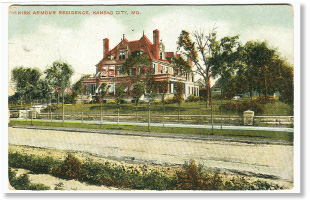
By MICHAEL BUSHNELL
Northeast News
November 28, 2012
When Kirkland B. Armour began construction of his palatial mansion on the boulevard that bears the name of his uncle, Simeon B. Armour, the roadway was barely more than a widened city street. This hand-colored postcard published “expressly for S.H. Knox & Co.” of Kansas City shows a time when the road was still covered with macadam and lined with newly planted Dutch Elm trees.
Armour was then-president of the Armour Brothers Packing House – one of the many meat-packing houses located in the West Bottoms between Kansas City, Mo., and Kansas City, Kan. When the mansion was completed, the street still was known as Commonwealth Avenue. It was not changed to Armour Boulevard until early in the 1900s following the adoption of city planner George Kessler’s forward-thinking plan that ultimately became
Kansas City’s parks and boulevards system.
In typical Armour style, the house was the largest and most architecturally significant of the many mansions once located along Armour Boulevard stretching between Broadway and The Paseo.
In the 1890s, Armour, with his brother Charles, purchased roughly 1,000 acres of farmland near what is now Meyer Circle and began buying exotic breeds of cattle that once comprised the Queen’s Herd in Great Britain.
After Armour’s death in 1901, the home was used as a school by an order of French Nuns named Notre Dame de Sion. Sadly, the home and its great stable were razed in the 1950s to make way for a modern office building once occupied by the Standard Oil Company. No evidence of the house or the stable exists today.











